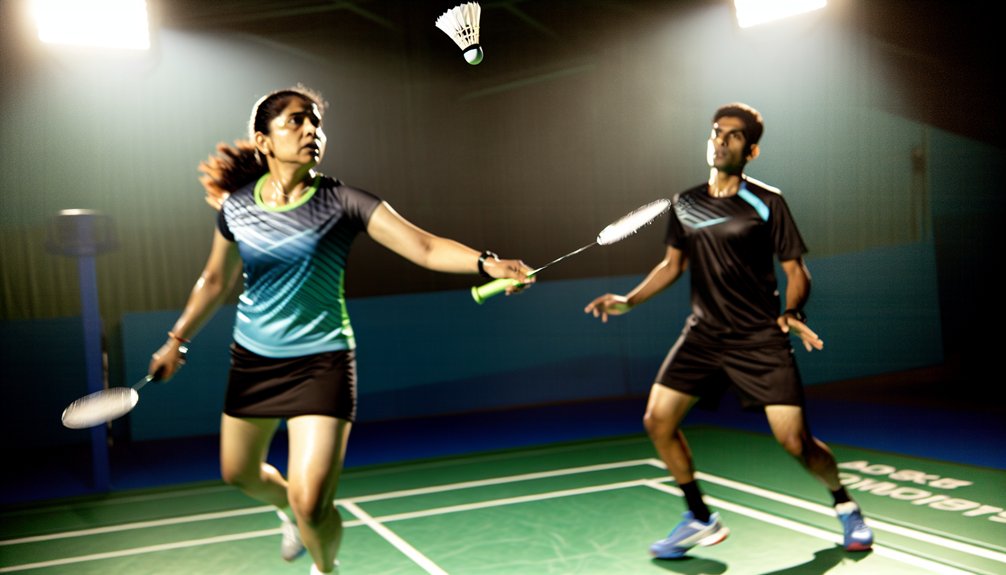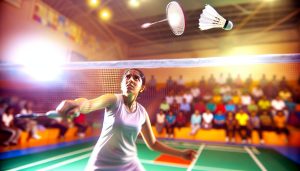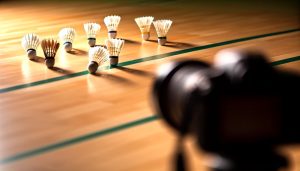To excel in doubles badminton, focus on clear communication with your partner using simple cues. Anticipate opponents' moves by reading their body language and positioning yourself strategically. Balance your court coverage with formations like front-back for offense or side-by-side for defense. Incorporate quick reaction drills to enhance agility and footwork. Employ versatile serves to keep opponents off-balance. Embrace setbacks as learning opportunities and stay mentally resilient. Ready to elevate your doubles game even further?
Key Takeaways
- Establish clear communication signals for effective coordination and decision-making on the court.
- Use front-and-back or side-by-side formations to optimize court coverage and adapt to game situations.
- Predict opponents' shots by analyzing body language and positioning for strategic counterattacks.
- Incorporate agility drills and footwork exercises to enhance speed and movement efficiency.
- Develop mental resilience to transform pressure into opportunity and maintain focus during matches.
Mastering Effective Communication With Your Partner
When it comes to badminton doubles, effective communication with your partner can be the key to success. You've got to guarantee signal clarity by establishing a set of simple, consistent gestures or words that both of you understand. This way, you're always in sync and can react quickly during a match.
Clear verbal cues can make a big difference, especially in fast-paced games. Don't hesitate to call out tactical moves or alert your partner about the shuttle's trajectory.
Encourage open communication with your partner off the court as well. Discuss strategies and develop a shared language that boosts your confidence and trust in each other. Always provide positive feedback and support, building a strong, collaborative relationship.
Positioning and Rotation: Understanding Court Coverage
In doubles badminton, it's crucial to communicate efficiently with your partner to cover the court effectively.
By understanding ideal positioning and working in sync, you both can anticipate each other's movements and reduce gaps in your defense.
Efficient Partner Communication
Although mastering efficient partner communication on the badminton court might seem challenging, it's an essential skill that elevates team play to new heights. You and your partner can create a seamless connection by developing clear partner signals and verbal cues.
These tools help you anticipate each other's moves and adjust rapidly during play. For example, a simple hand gesture can indicate when you plan to move forward, while a quick shout of "yours" or "mine" clarifies who'll take the next shot.
Encouraging open dialogue fosters trust and reduces errors, allowing you to focus on strategy rather than confusion. Remember, practice makes perfect. As you refine your communication, you'll notice your team synergy growing stronger with each game.
Optimal Court Positioning
Building on the foundation of effective communication with your partner, understanding ideal court positioning can take your doubles game to the next level.
Focus on court awareness to guarantee you and your partner effectively cover the space. Proper space management is vital; it helps you anticipate the opponent's moves and react swiftly. Stay alert and dynamic, always ready to rotate positions based on the shuttle's direction.
Remember, front-and-back or side-by-side formations work best depending on the situation. When you're in sync with your partner, your positioning becomes seamless. A strong court presence minimizes gaps, making it harder for opponents to exploit weaknesses.
Trust your instincts, communicate clearly, and maintain flexibility to adjust your positioning. You'll find yourself more confident and successful on the court.
Anticipating and Countering Opponents' Shots
When you step onto the badminton court, anticipating and countering your opponents' shots becomes your secret weapon. Shot prediction is essential; it involves reading your opponents' body language and understanding their favorite plays. Watch how they hold their racket or their positioning. These clues are your allies in predicting their next move.
Another key aspect is opponent analysis. Pay attention to their strengths and weaknesses. Do they favor cross-court smashes, or are they more likely to drop the shuttle at the net? Recognizing these patterns helps you prepare and react swiftly.
Once you've got a good read, it's all about positioning yourself effectively and preparing your counterattack. Stay light on your feet, ready to pounce on those opportunities.
Serving and Receiving: Setting the Tone for the Rally
Anticipating and countering your opponent's shots sets the stage, but it's the serve and receive that truly ignite the rally. Your service strategies can be the secret weapon that catches opponents off guard. A well-executed serve puts you in control from the start, dictating the pace and positioning your team for success.
Consider varying your serves—short, flick, or drive—to disrupt the opponent's rhythm and keep them guessing.
Receiving isn't just about returning the shuttle; it's about setting the rally dynamics in your favor. Position yourself ready to pounce on short serves and quickly retreat for deep ones.
Use your return to place the shuttle where it creates the most challenge for your opponents, pushing them out of their comfort zones.
Utilizing Offensive and Defensive Formations
Although mastering the art of serving and receiving is essential, understanding how to effectively utilize offensive and defensive formations can elevate your doubles game to new heights. When you're on the attack, adopting offensive strategies like the front-back formation guarantees constant pressure on your opponents. This setup allows one player to dominate the net, while the other controls the mid and backcourt. On defense, switching to a side-by-side formation can maximize court coverage, enabling quick reactions to your opponents' smashes and drops.
Here's a quick guide to stir your strategic creativity:
| Formation Type | Emotional Impact |
|---|---|
| Front-Back | Aggressive, Dominant |
| Side-by-Side | Secure, Balanced |
| Rotational | Dynamic, Adaptive |
| Mixed | Versatile, Unpredictable |
Exploiting Opponents' Weaknesses
While every player has strengths, they also have areas they struggle with. To excel in doubles, it's essential to identify and exploit these weaknesses through smart opponent analysis.
Start by observing your opponents closely. Do they've trouble returning shots to their backhand? Are they slow to react to drop shots? Take note of these tendencies.
Once you've gathered insights, tailor your shot selection to target these weaker areas. If you notice a player consistently mishandling low shots, incorporate more net plays into your strategy.
If they're not comfortable with fast-paced rallies, keep the tempo high. By focusing your shots on their vulnerabilities, you're not only maximizing your chances of winning points but also building your confidence and strategic skills.
Developing Quick Reflexes and Adaptability
To excel in doubles, you need to sharpen your ability to anticipate your opponent's movements and react quickly under pressure.
By staying alert and reading their body language, you can predict their next shot and position yourself effectively.
With practice and focus, you'll build the adaptability needed to handle any fast-paced exchanges confidently.
Anticipating Opponent's Movements
Have you ever wondered how top badminton players always seem to know where the shuttlecock will land next? It's all about reading cues and understanding body language. By observing your opponent's stance and movements, you can anticipate their next shot. Notice how they hold their racket or the angle of their shoulders—these small details provide valuable information about their intentions.
Developing quick reflexes and adaptability is essential. Stay alert and responsive by practicing drills that improve your reaction time. The more you play, the better you'll become at predicting your opponent's actions.
Trust your instincts and stay engaged in the game. With practice, you'll read the game more effectively and position yourself strategically, giving you a competitive edge in doubles matches. Keep at it!
Reacting Under Pressure
Mastering the art of anticipating your opponent's movements is just one piece of the puzzle in badminton.
Equally important is how you react under pressure. Developing quick reflexes and adaptability is vital when pressure tactics come into play. Stay calm and focus on the shuttlecock, not the stress. Mental resilience will help you turn pressure into an opportunity to shine.
In doubles, every second counts, so practice drills that enhance your reaction time.
Try shadow badminton to improve your footwork and speed. Engage in dynamic exercises, like quick rallies, to boost agility.
Remember, mistakes are part of learning; embrace them and use them to grow.
You're not alone—your partner's support and teamwork make overcoming pressure a shared victory.
Frequently Asked Questions
How Can I Improve Mental Focus During a Doubles Match?
To improve mental focus during a doubles match, try visualization techniques to mentally rehearse key plays. Coupled with deep breathing exercises, you'll calm your mind, stay present, and boost your performance. You've got this!
What Are the Best Dietary Habits for Peak Performance in Badminton Doubles?
Did you know proper nutrition can boost performance by 15%? Focus on balanced nutrition strategies and stay hydrated. Drink water regularly and fuel with lean proteins and complex carbs. You're on your way to peak performance!
How Do I Choose the Right Doubles Partner for My Playing Style?
To choose the right doubles partner, focus on complementary playing styles and strong partner chemistry. Observe how you both communicate and support each other. Trust your instincts and prioritize mutual respect to enhance your game positively.
What Are Common Mistakes to Avoid in Doubles Badminton?
Are you making poor communication or positioning errors on the court? Focus on clear signals with your partner and staying in the right spot. You'll improve your game and enjoy more victories together. Keep practicing!
How Can I Prevent Injuries While Playing Doubles Regularly?
You can prevent injuries by incorporating warm-up routines and stretching techniques into your pre-game ritual. Stay consistent, listen to your body, and encourage your partners to do the same. You're investing in a stronger, more resilient team.
Conclusion
You've now got all the tactics to become a doubles master, but ironically, it's not about memorizing each one. It's about playing with heart and having fun, because who knew that laughing with your partner could be the ultimate strategy? Embrace the chaos, relish the challenge, and surprise yourself with those reflexes you didn't know you had. Remember, every misstep is just another step towards becoming the player you always knew you could be.








